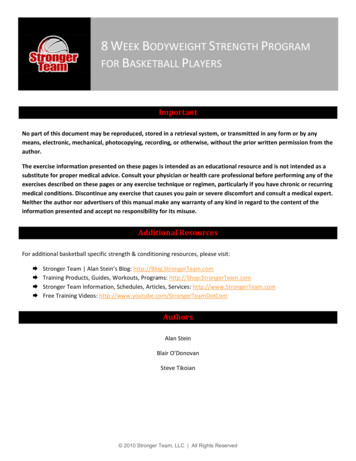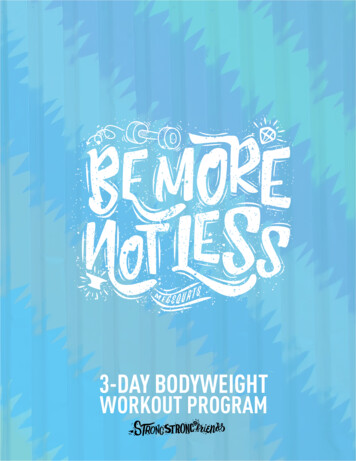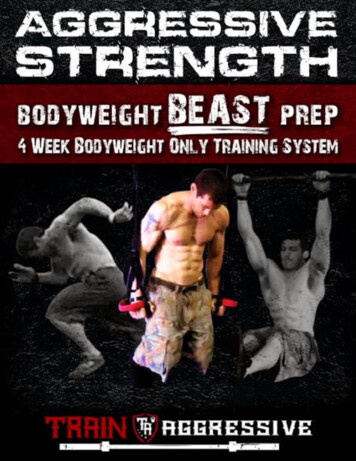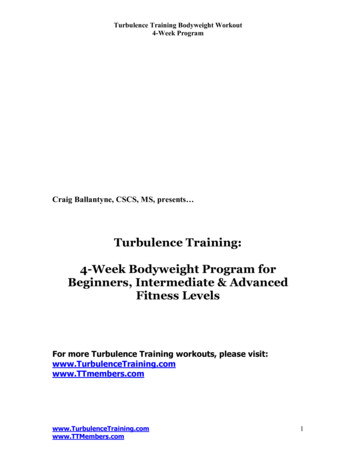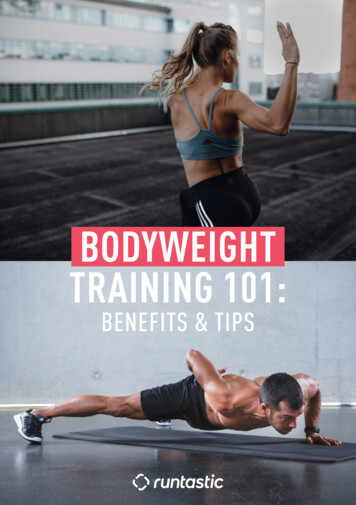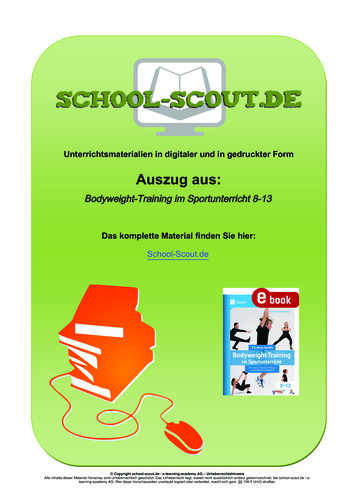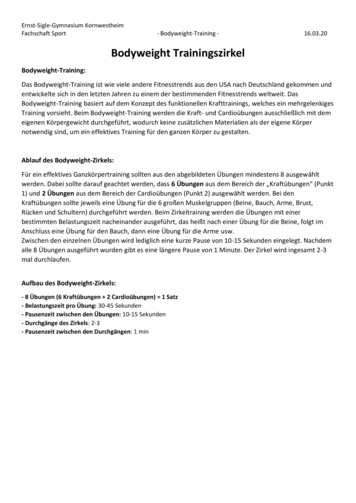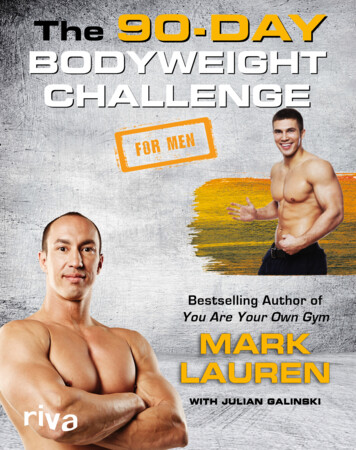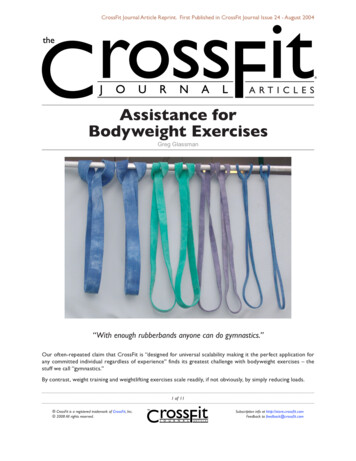
Transcription
CrossFit Journal Article Reprint. First Published in CrossFit Journal Issue 24 - August 2004Assistance forBodyweight ExercisesGreg Glassman“With enough rubberbands anyone can do gymnastics.”Our often-repeated claim that CrossFit is “designed for universal scalability making it the perfect application forany committed individual regardless of experience” finds its greatest challenge with bodyweight exercises – thestuff we call “gymnastics.”By contrast, weight training and weightlifting exercises scale readily, if not obviously, by simply reducing loads.1 of 11 CrossFit is a registered trademark of CrossFit, Inc. 2008 All rights reserved.Subscription info at http://store.crossfit.comFeedback to feedback@crossfit.com
Assistance for Bodyweight Exercises (continued.)With training bars and training plates we’ve been able tointroduce the major lifts like squats, deadlifts, pressesand jerks, cleans, and the snatch to all comers, includingseniors, regardless of ability. This approach is notnovel; many of the most successful and sophisticatedweightlifting programs start everyone out with PVCpipe or wooden dowel systems of negligible weight andonly increase loads in tiny increments when executionis good.But bodyweight exercises create a special dilemma.Most women, seniors, and larger men are typicallychallenged to complete a single rep of even the mostrudimentary bodyweight movements. This is most trueof basic upper body exercises like the pull-up, push-up,or dip.For years assisted pull-up and dip machines likethe Stairmaster Gravitron have been our staple forintroducing, training, and developing bodyweightexercises.While we’ve met with considerable success with thisapproach it does have several nagging shortcomingsincluding the substantial cost of the machines themselves,their discontinued production in the case of theGravitron, less than optimal or natural lines of action,limited accessibility with larger numbered groups, andthe inherent limitation of developing only two exercises– the pull-up and dip.This month we explore additional assistance strategiesthat broaden both the pool of athletes able to participatein basic bodyweight exercises and the number ofbodyweight exercises.We’ll show how not only the pullup and dip, but alsothe muscle-up, rope climb, iron cross, and handstandpush-up can be worked by anyone.Additionally, we’ll present strategies by which the frontlever, planche, maltese cross, inverted cross, elevator,and ring handstand pushup can be practiced by athletesmore capable yet still far from strong enough for theseclassics.The gymnastics realm is every bit as potent asweightlifting and weight training and nearly untappedin fitness programs, commercial gyms, military andlaw enforcement training, and athletic strength andconditioning worldwide.Weight training is a critical component of fitness trainingbut, ultimately, represents a vehicle for tapping onlyhalf of your physical potential – the rest depends ongymnastics. This is true of strength in general and upperbody and core strength in particular, but in the arenaof neurological development the gymnastics stimulus issingularly unique.No discipline approaches gymnastics’ capacity fordeveloping strength to weight ratio, upper bodystrength, core strength, flexibility, coordination,accuracy, agility, and balance. (Pilates fans, yogis, Swissballers, wobble and Indo boarders take note: you areplaying, not training!)The barrier to participation in gymnastics is twofold.The first difficulty is scaling load. Imagine if the only loadavailable in gyms were bodyweight loads. What wouldthat do to the popularity of weight training? It wouldclose nearly every gym in the world. There would be asmany people lifting weights as there are doing gymnastics– damned few.The second barrier to gymnastics participation is lessapparent to most athletes and coaches but every bit theimpediment that scalability is. Gymnastics movementsat every level require extraordinary body control.Gymnastics is to weight training as the tambourine isto the violin. Weak mindedness manifested as a lowtolerance for frustration culls the herd.Benefit from and need for the gymnastics stimulus isnot blunted by age, weight, or gender. In fact, thosepopulations least likely to find themselves above the ringsor upside down benefit greatest from the exposure.Toughen up, get some rubber bands, and get to work.None of the strategies we’ve explored are our design– most can be found in Cuk and Karacsony’s book Rings– Methods, Ideas, Curiosities, and History. What is uniquelyCrossFit is both using these techniques with specialpopulations and advocating their use for nongymnasticsathletic strength and conditioning.2 of 11 CrossFit is a registered trademark of CrossFit, Inc. 2008 All rights reserved.Subscription info at http://store.crossfit.comFeedback to feedback@crossfit.com
Assistance for Bodyweight Exercises (continued.)Jimmy Johnson/Handstand push-ups:Santa Cruz Sheriff’s Deputy Jimmy Johnson is a big,strong man but not ready for unassisted handstandpush-ups. We attached him to a Yates ankle harness towhich we added a couple of FlexBands and hauled him upto the handstand with a 4:1 block and tackle system. Bycontrolling the tension on the bands we could preciselydetermine the amount of assistance Jimmy was gettingand he was able to do his first handstand push-ups. Onfailure, we could pull a little more rope, which stretchedthe bands a little more, and he was good for a few morereps.“ChemGirl”/HandstandPush-up:By controlling the amount of pre-stretchon the FlexBands “ChemGirl” can bemade as light as needed for practicinghandstand push-ups.3 of 11 CrossFit is a registered trademark of CrossFit, Inc. 2008 All rights reserved.Subscription info at http://store.crossfit.comFeedback to feedback@crossfit.com
Assistance for Bodyweight Exercises (continued.)Ernie Ellender/Front Lever &Mary Poteete/Iron CrossBoth can practice their iron cross and front lever with FlexBandsattached to a climbing harness and pulled tight with block and tackle.Jonna Mendes/Muscle-up:Two time U.S. Olympian Jonna Mendes needs a littleassistance for the muscle-up. We put her in a climbingharness to which we attached two FlexBands andhauled the bands upward with block and tackle preciselycontrolling the amount of assistance needed to get heron top of the rings.4 of 11 CrossFit is a registered trademark of CrossFit, Inc. 2008 All rights reserved.Subscription info at http://store.crossfit.comFeedback to feedback@crossfit.com
Assistance for Bodyweight Exercises (continued.)Garth Taylor/Muscle-up:With FlexBands and block andtackle Brazilian Jiu-jitsu championGarth “Mountain Man” Taylor cando a muscle-up.Sally Stade/Iron Cross:Sally Stade is holding an iron cross on rings tied to ropesthat run up to the ceiling, through pulleys and down toloading pins and plates. Her iron cross can be measuredas a percentage of her body weight telling her how closeshe is to the real thing.Sally Stade/Iron Muscle-up:Again with rings tethered to a rope that runs up to apulley and back down to two loading pins and plates wecan measure how close Sally actually is to the muscleup.5 of 11 CrossFit is a registered trademark of CrossFit, Inc. 2008 All rights reserved.Subscription info at http://store.crossfit.comFeedback to feedback@crossfit.com
Assistance for Bodyweight Exercises (continued.)Sally Stade/Muscle-up:This time with our rings attached tothe ceiling with FlexBands, Sally Stadecan practice the muscle-up without herfeet ever leaving the ground. Setting thefalse grip becomes easy, the transitionmanageable and the dip adequatelychallengingJack Hespel/Inverted Cross:It’s been 40 years since Jack Hespel’s gymnastics days,but with rings attached to a rope that runs up througha pulley and back down to the ankle harness Jack is backin action with an inverted cross. Again, this system cutsJack’s weight in half.6 of 11 CrossFit is a registered trademark of CrossFit, Inc. 2008 All rights reserved.Subscription info at http://store.crossfit.comFeedback to feedback@crossfit.com
Assistance for Bodyweight Exercises (continued.)Lani Lau/Ring Handstand Push-ups:Lani Lau is attached to the Yates ankle harness, which in turn is attached to a rope that runs up to a Petzl pulley andback down to the rings. This halves the bodyweight and allows Lani to do still-ring handstand push-ups, preservinga lot of the live feel of the real movement.Matt Mast/Planche:With rings, rope, pulley, and climbing harness Matt does a planche.7 of 11 CrossFit is a registered trademark of CrossFit, Inc. 2008 All rights reserved.Subscription info at http://store.crossfit.comFeedback to feedback@crossfit.com
Assistance for Bodyweight Exercises (continued.)Matt Mast/Elevator:The “elevator” starts with an inverted hang and false grip. The movement is performed by curling to the shoulderstand and then pressing to the handstand. This is like an upside down muscle-up and handstand push-up combination.It’s a whole lot easier at half body weight.8 of 11 CrossFit is a registered trademark of CrossFit, Inc. 2008 All rights reserved.Subscription info at http://store.crossfit.comFeedback to feedback@crossfit.com
Assistance for Bodyweight Exercises (continued.)Garth Taylor/Front Lever:Not too many guys at 270 pounds cando a front lever. With the ring andpulley set-up attached to a climbingharness his hips are lifted enough tomake the move possible.Sally Stade/Bar Dips:Standing on a FlexBand looped over the ends of the parallel bars Sally Stade is able to perform dips. The assistancecan be increased by adding another band or by twisting another loop around either or both bars.9 of 11 CrossFit is a registered trademark of CrossFit, Inc. 2008 All rights reserved.Subscription info at http://store.crossfit.comFeedback to feedback@crossfit.com
Assistance for Bodyweight Exercises (continued.)Sally Stade/Pull-ups:Looping a FlexBand over the pull-up bar forms a loop into which Sally can stand and receive enough assistance todo pull-ups.Sally Stade/Rope Climb:Here Sally Stade, in a climbing harness, is attached to a FlexBand stretched and fixed to the same attachment pointas the top of the rope. With the addition of another band Sally could climb the rope without using her legs.10 of 11 CrossFit is a registered trademark of CrossFit, Inc. 2008 All rights reserved.Subscription info at http://store.crossfit.comFeedback to feedback@crossfit.com
Assistance for Bodyweight Exercises (continued.)EquipmentYates Gear WristletClimbing HarnessOur old ankle harness lookedlike a leg restraint on an electricchair. It was designed with thesame comfort in mind. This Yatesharness is fantastic. Thoughfeatured as a wrist harness, it wastested and approved for ankle use.Not one athlete complained aboutdiscomfort. We can’t imagine abetter, safer, more comfortableway to haul someone upsidedown.Our harness was manufactured byour military friends. Our next onewill come from Metolius.Jump Stretch FlexBandsBand set. One pair each of mini,light, average, and strong bands.We’re looking for cheaper rubberbands. Let us know if you findthem.Petzel Oscillante PulleyThis inexpensive pulley squeakedintolerably until we hit it withsome WD-40. It seems to havemoderate rolling resistance.Greg Glassman is the founder (with LaurenGlassman) of CrossFit, Inc. and the publisher ofthe CrossFit Journal.11 of 11 CrossFit is a registered trademark of CrossFit, Inc. 2008 All rights reserved.Subscription info at http://store.crossfit.comFeedback to feedback@crossfit.com
rudimentary bodyweight movements. This is most true of basic upper body exercises like the pull-up, push-up, or dip. For years assisted pull-up and dip machines like the Stairmaster Gravitron have been our staple for introducing, training, and developing bodyweight exerc

